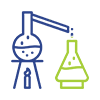AI in Risk Assessment: How Smart Technology is Redefining Business Safety
Introduction
Risk is an unavoidable part of business. Whether it’s financial uncertainty, cybersecurity threats, supply chain disruptions, or regulatory compliance, companies constantly face challenges that can make or break their success. Traditionally, risk assessment has relied on human expertise, historical data, and manual analysis—methods that are slow, prone to bias, and often reactive rather than proactive.
But what if businesses could predict risks before they happen? What if they could analyze thousands of data points in seconds and make decisions with near-perfect accuracy?
That’s where Artificial Intelligence (AI) comes in.
AI-powered risk assessment is transforming industries by providing real-time insights, reducing human error, and uncovering hidden patterns that traditional methods miss. From banks detecting fraud to manufacturers preventing equipment failures, AI is making risk management faster, smarter, and more reliable.
In this article, we’ll explore:
- How AI is changing risk assessment
- Real-world applications across industries
- The ethical considerations of AI-driven decisions
- Steps businesses can take to integrate AI into their risk strategies
The Problem with Traditional Risk Assessment
Before AI, risk assessment was largely a manual process. Analysts would:
- Review historical data
- Use spreadsheets and static models
- Depend on human judgment, which can be biased or inconsistent
While these methods worked to some extent, they had major flaws:
- Slow and Reactive
Human analysts can’t process vast amounts of data quickly. By the time risks are identified, it’s often too late to prevent damage.
Example: In financial fraud detection, traditional systems might flag suspicious transactions after the money is already stolen.
- Prone to Human Bias
Studies show that human decision-making in risk evaluation is influenced by unconscious biases. For instance:
- Loan approvals may be affected by demographic factors rather than pure creditworthiness.
- Insurance claims might be unfairly denied due to subjective judgments.
- Limited by Historical Data
Traditional models rely on past trends, but they struggle with unprecedented events—like a pandemic or a sudden market crash.
How AI is Revolutionizing Risk Assessment
AI addresses these weaknesses by introducing speed, accuracy, and predictive power. Here’s how:
- Real-Time Data Processing
AI algorithms can analyze millions of transactions, sensor readings, or market changes per second, spotting anomalies instantly.
Example:
- JPMorgan Chase’s COiN platform uses AI to review legal documents in seconds—work that previously took 360,000 human hours annually. (Source: Business Insider)
- Machine Learning for Predictive Insights
Unlike static models, machine learning (ML) improves over time. It detects patterns humans can’t see and predicts risks before they materialize.
Use Case:
- Healthcare: AI models predict patient health risks by analyzing medical records, genetics, and lifestyle data.
- Supply Chain: AI forecasts disruptions (like weather delays or supplier failures) and suggests alternatives.
- Reducing Human Bias
AI, when properly trained, makes decisions based on data—not gut feelings. For example:
- Mortgage approvals can be automated using AI that ignores race, gender, or age, focusing only on financial behavior.
- Insurance underwriting becomes fairer when AI assesses risk purely from historical claims data.
Real-World Applications of AI in Risk Management
- Financial Services: Fraud Detection & Credit Scoring
Banks and fintech companies use AI to:
- Detect fraudulent transactions in real-time (e.g., Mastercard’s AI stops $20B in fraud annually). (Source: Mastercard)
- Assess credit risk more accurately by analyzing non-traditional data (e.g., social media activity, utility payments).
- Cybersecurity: Predicting & Preventing Attacks
AI-powered security systems:
- Identify unusual network behavior (e.g., an employee accessing files at 3 AM).
- Predict phishing attempts before they succeed.
Example: Darktrace’s AI stops cyber threats by learning a company’s “normal” digital patterns and flagging deviations.
- Manufacturing: Predictive Maintenance
Instead of waiting for machines to break, AI:
- Monitors equipment sensors for early failure signs.
- Schedules maintenance before costly downtime occurs.
Result: General Electric’s AI-driven maintenance reduced downtime by 20-50% in some plants. (Source: GE Reports).
Ethical Concerns & Challenges
While AI offers huge benefits, it’s not without risks:
- Data Privacy Issues
AI needs massive datasets—but collecting personal data raises GDPR and compliance concerns.
- Algorithmic Bias
If AI is trained on biased data, it reinforces discrimination. For example:
- Amazon scrapped an AI recruiting tool because it favored male candidates. (Source: Reuters)
- Over-Reliance on AI
Blindly trusting AI without human oversight can lead to catastrophic errors.
How Businesses Can Start Using AI for Risk Assessment
Step 1: Identify Key Risk Areas
- Fraud? Supply chain? Compliance? Focus on high-impact areas first.
Step 2: Choose the Right AI Tools
- Off-the-shelf solutions (e.g., IBM Watson, SAS Fraud Detection).
- Custom AI models (for niche needs).
Step 3: Train AI with Clean, Unbiased Data
- Garbage in = garbage out. Ensure datasets are diverse and representative.
Step 4: Monitor & Improve Continuously
- AI isn’t “set and forget.” Regularly audit its decisions for fairness and accuracy.
Conclusion: The Future of Risk Assessment is AI-Driven
AI isn’t replacing human judgment—it’s enhancing it. By automating data analysis, predicting risks, and reducing bias, AI allows businesses to act faster, smarter, and more confidently.
Companies that adopt AI-powered risk assessment today will outperform competitors tomorrow. The question isn’t if you should integrate AI—it’s how soon you can start.
Ready to explore AI for your business? Check out Avenga’s AI solutions or drop a comment below with your thoughts!
References & Further Reading
- Avenga. (2023). Integrating AI for Smarter Risk Assessment. https://www.avenga.com/magazine/integrating-ai-for-smarter-risk-assessment/
- IBM. (2022). How AI is Transforming Risk Management. https://www.ibm.com/risk
- McKinsey. (2021). The State of AI in Financial Services. https://www.mckinsey.com/industries/financial-services

 Iron & Steel
Iron & Steel
 Power
Power
 Plywood & Lamination
Plywood & Lamination
 Sugar
Sugar
 Tea
Tea
 Oil & Gas
Oil & Gas
 Solar & Wind
Solar & Wind
 Agriculture
Agriculture
 Chemical
Chemical
 Food Product
Food Product
 Real Estate &
Construction
Real Estate &
Construction
 Logistics
Logistics
 Automobile
Automobile

.jpg)